From Portugal to Spain and Back...
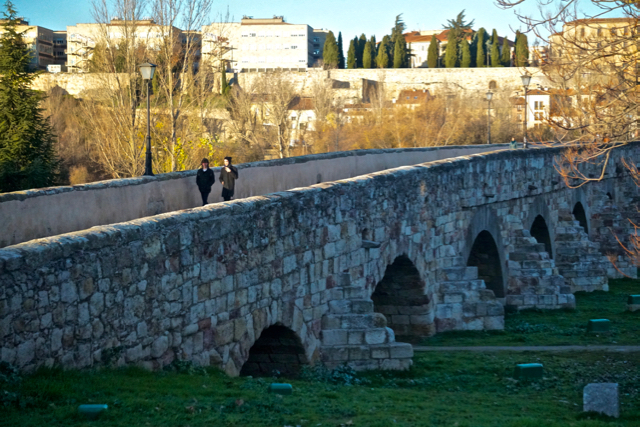
Writing this blog on the return flight from Spain to the US, my challenge in writing is to choose which aspects of the trip to highlight. There are more stories than I have the time or space to relate at length.
Thus, my brief listing of some interesting facts about Portugal:
- Portuguese is the fifth most-spoken language in the world, consisting of approximately 250 million speakers, 190 million of whom live in Brazil, as well as Angola and Mozambique in Africa.
- In Portugal, the public universities are superior to and preferable to private ones. Private universities cater to students who have trouble passing the difficult entrance exams controlling entrance to the public universities.
- Public universities cost students 1100 Euros/year (approx. $1200 at the current strong-dollar exchange rate). Foreign students must pay 2100Euros/year, a bargain compared to American universities.
- Portugal has a universal-access public healthcare system. As in education, so in healthcare…public hospitals are better than private ones. Private hospitals are utilized primarily for elective procedures. Also, waiting times in general are shorter than in the public hospitals. But complicated surgeries or life-threatening crises are always handled in the public hospitals rather than the (generally smaller) private ones.
- Portugal has no petroleum resources. To reduce import costs, it has strongly promoted wind and solar alternative energy. On a particularly sunny and windy month, wind and solar generated 93% of Portugal’s electricity. The current average amount from alternative sources is around 50%. Portugal hopes to achieve 100% electricity generation from wind and solar by 2025.
- Portugal and England were naval allies against the Spanish, culminating in Admiral Wellington’s famous defeat of the Spanish armada, the world’s largest naval force at that time.
- Port wine (red) and Muscatel (white) are “fortified” wines, meaning that their alcohol level is raised by the addition of high alcohol brandy. This was done originally to stop the fermentation process before all the natural sugars could be converted to alcohol, the normal wine-making technique which results in a dryer wines with higher alcohol levels.
- The shift to fortified wine occurred because regular wine being shipped to England turned to vinegar enroute. The addition of brandy to the young sweet wine kills the yeast thus preserving the sweetness that has come to exemplify Port wines. Of course, there are many conventional wines produced in Portugal, including Vinho Verde (“green wine”) available at Trader Joe’s.
- Author J. K. Rowling lived for ten years in Portugal. She incorporated several aspects of Portuguese culture into her Harry Potter series, such as the black caped costumes worn by university students in Portugal, which became the costumes worn at Hogwarts by both faculty and wizard students.
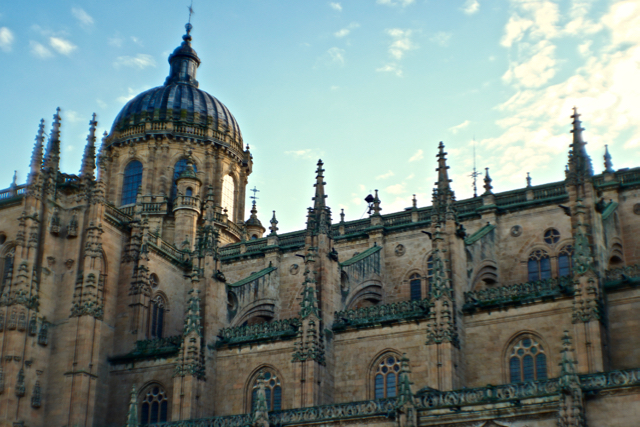
Salamanca, Spain
Our guided tour with Viking River Cruises took us by bus to the Spanish city of Salamanca. Previously unfamiliar to me, Salamanca is a famous university city, home to over forty-five thousand students, including fifteen thousand Americans who enroll there to learn Spanish. As in Portugal, the cost of studying at universities is Spain is much less than in the US.
Salamanca’s famous “new” cathedral (which abuts the original “old” cathedral) took two centuries to construct, from the 16th till the 18th centuries. It is surrounded by ornate medieval buildings used by the university, which was founded in 1218, making it Spain’s oldest and the fourth oldest university in the world. There is an electronic clock counting down to the upcoming 800-year anniversary of the university’s founding. The city with its famous cathedral was important in the re-Christianizing of the Iberian peninsula (Spain and Portugal) following four hundred years of Moorish (Moslem) rule. Salamanca has UNESCO world-heritage status.
Salamanca is a famous pilgrimage point for Christian pilgrims in previous centuries and continuing into present times. Pilgrims typically visited Salamanca before walking through what is now Portugal, visiting various cathedrals there, before turning north to the final goal of Santiago de Compostela, the second Spanish city in our Viking tour following our voyage up and down the Douro River Valley.

Santiago de Compostela, Spain
The name Santiago de Compostela translates as “St. James-Field of Stars”. That name is based on the following background story, leading up to the founding of the city in the ninth century AD. This is how the history was explained by our guide:
Jesus’s disciple James, following Jesus’s crucifiction and resurrection, traveled to that are of northern province of Spain known as the area of Galicia, which was part of the Roman empire at that time. He spent eight years there, spreading the teachings of Jesus and gaining some followers. After those years, he returned to Jerusalem, which was also ruled by the Romans. I didn’t understand why, but the Romans executed him by beheading. Somehow, some of his followers carried his body (and head, I suppose) back to Galicia to be buried.

The location of his grave was lost for centuries. In the meantime, the Roman Empire fell, the Visigoths (Germanic tribal warriors) invaded Iberia, followed by the Moors from North Africa who occupied much of Iberia but never conquered Galicia. Galicia retained the Christian forces who eventually expelled the Moors. The legend of St. James was well known in Galicia, leading people searched for his grave. In the year 813, a shepherd followed the “field of stars” were led to a hill in Galicia where he discovered (supposedly) St. James’s grave. Word of this discovery was sent to the pope in Italy, who decreed that a church should be built on that spot.
The Santiago cathedral, first consecrated in 1211, is impressive, grand and filled with amazing sculptures, carved figures, and gold leaf-covered figures. It is not as large as the Vatican, but on a smaller scale, it strives for that level of grandeur. The cathedral took two centuries to build, though additional artworks were continually added to its glittering interior, as well as Baroque facades in the 18th century. Like Salamanca, Santiago de Compostela is a designated World Cultural Heritage Site.
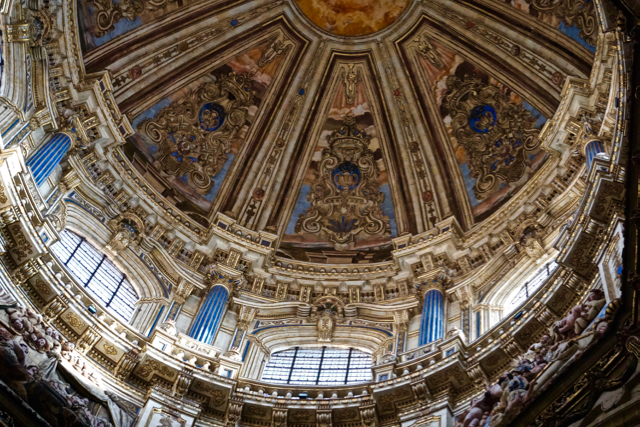
Religious pilgrimages, ancient and modern
Sometime after the cathedral’s completion, the pope in Rome declared Santiago de Compostela to be the third most important destination for faithful pilgrims, after Rome and Jerusalem. And so for almost a thousand years, Santiago has been visited by devout Christian pilgrims, walking the “Way of Saint James”. Because it’s now winter (as well as the Christmas holidays), we didn’t see any pilgrims during our short visit. But Santiago received approximately a quarter million pilgrims in 2015, from the low of 1500 pilgrims in January to the peak of sixty-one thousand pilgrims in the month of September 2015!

There is a protocol for modern pilgrims. They must register at one of several Pilgrim’s Centers in Spain. The would-be pilgrim registers and receives a log-book. To achieve pilgrim status, the pilgrim must walk at least 100 km/67 miles, obtaining stamps from various points (chapels and hostels) along one of the officially recognized routes. Should the pilgrim choose to travel by bicycle, he/she must travel twice as far, 200 km/133 miles, all the while getting their log-books stamped along the way. When they finally reach Santiago de Compostela, they take their log book to the Pilgrim’s Center for validation, after which they are given a certificate in Latin which attests to their having achieved official recognition.
I hadn’t thought about how much the great religions have in common in this regard until being reminded of this ancient Christian tradition. The Islamic imperative, that all Moslems should visit Mecca once in their lives, is better known (after which the Moslem pilgrim attains the name Haji, for the Haj, or visit to Mecca). Buddhists visit temples in India, Nepal, and Sri Lanka, which supposedly contain relics (body parts or possessions) of Buddha. Hindus make pilgrimages to holy places in India, including one I heard of in the Himalayas that is only accessible in mid-summer, consisting of a narrow steep passage up to a holy Hindu temple. If a pilgrim in this strenuous ascent dies, the other pilgrims are forced to step over the dead bodies, since there is no way to reverse the stream of humanity pushing their way up the narrow mountain path.
I learned so much history of the rise of Catholicism during its first millennia and a half, that I realized that my Protestant-centric education had ignored this history. It was as if Christianity had been a stagnant corrupt religion until Martin Luther nailed his 95 Theses to the church wall in Germany, initiating the Protestant reformation. I heard about the collection of relics, the sale of “indulgences”, and the rival conflicting popes in Rome and Constantinople. The opulence of the Catholic cathedrals was rejected in favor of a more Puritanical style of Protestantism, which can be seen in the austere Lutheran churches of Northern Europe today.
I don’t know of any Protestant cathedrals that can compare with the grandeur of the Catholic ones. These cathedrals are often criticized for concentrating wealth in the form of gold, jewels, sculptures, and paintings, while the surrounding peasant populations are dirt-poor. Of course, the kings sought to associate themselves with the churches’ wealth and reverence. A clarification of terms that I learned: All cathedrals start as churches. There are many “churches”, but a church must have been home to a bishop at some point to be termed a cathedral. Thus, the term cathedral is not directly related to the scale of the physical structure of the church.


based on its proximity to the ocean
During my visits to many Hindu temples in India, I always found them to be outrageously garish in their various statues and artworks. But these ancient Catholic cathedrals are just as outrageous as some of my photos indicate. Certainly, there is a competition within all the religions as to which city can manage and afford to build the most impressive cathedral, temple, or mosque. I think I’m safe in saying that up until the middle-ages at least, the premiere examples of human constructions were those religiously-inspired buildings. (I exclude Egypt’s pyramids from this statement since their origins have been lost over time.)
It must be noted that during the time of the Crusades, when Christians drove out the Moors from the Iberian peninsula (present-day Spain and Portugal), the Christians also expelled the Jews. The Christians followed the ISIS doctrine of “convert or die.” Thus, the Christian cross of St. James is based on the sword. St. James’s statues often show him on a horse wielding a sword, though there’s no evidence that he ever did this during his lifetime.
In my humble opinion...
To conclude this series of blogs from this nine-day tour in Portugal and Spain, I offer this personal observation of European versus American consciousness. Europeans are constantly reminded of their long histories, by their ancient cathedrals, castles, and walled fortifications. They are reminded of their diverse histories by the constant presence of foreign tourists and immigrants. Europe’s history is, unfortunately, marked by centuries of national conquests, religious wars, and cultural conflicts. The relatively recent European Union (EU) has ushered in one of the longest periods without war in Europe’s history.
By contrast, in the US, we have very few historical buildings…just a few notable ones in Washington DC and Boston. Americans tend to see any building over fifty years old as ripe for demolition. Thus, we have a limited awareness of the historical forces that helped shape contemporary American culture.
Personally, traveling expands my perspective and makes me more accepting of different peoples and cultures. I recommend traveling to help see the US as part of the larger world, rather than some exceptional unique nation that has nothing to learn from other countries, their history, or culture. I would hope that this might inform and elevate our politics, as well as temper our current national policy of projecting US power through the presence of our military bases around the world, which are supposed to protect the US from our traditional enemies, Russia and China, as well as our newest enemy, radical Islam.
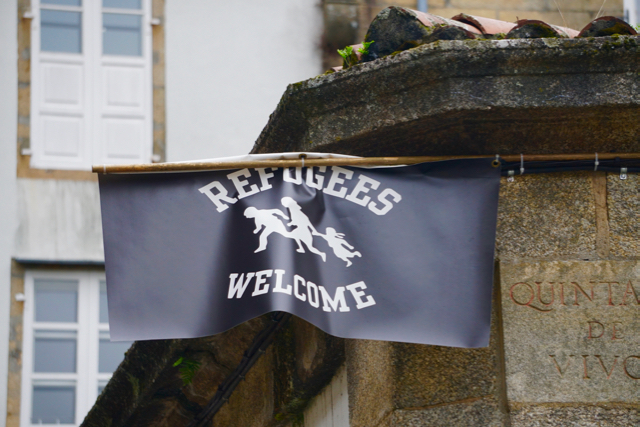
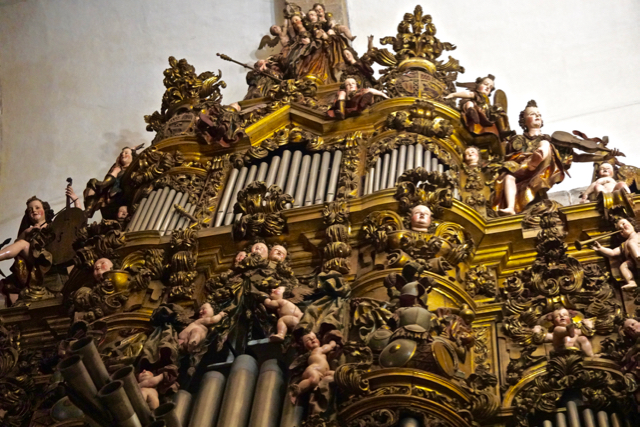
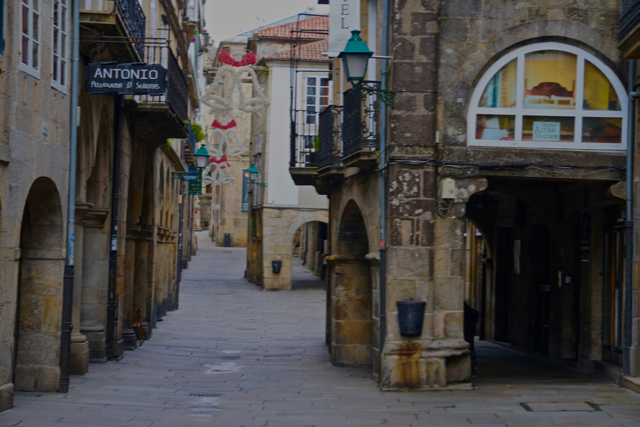
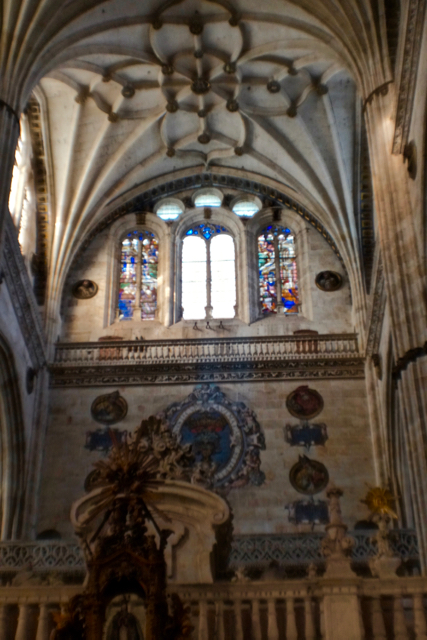
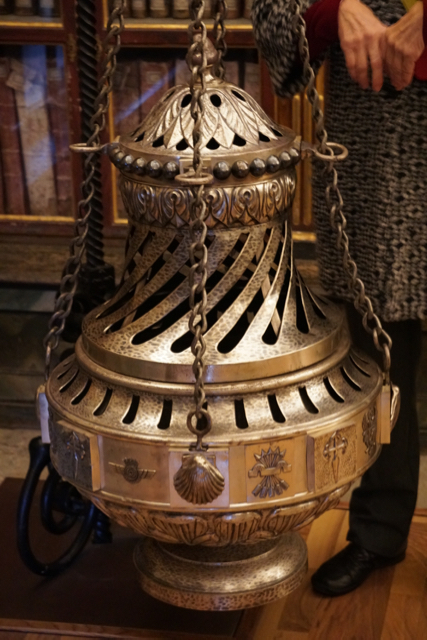
0 Comments on From Portugal to Spain and Back...
Join the Conversation